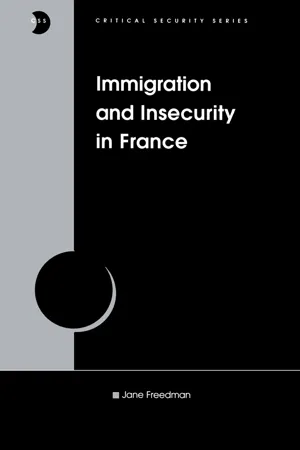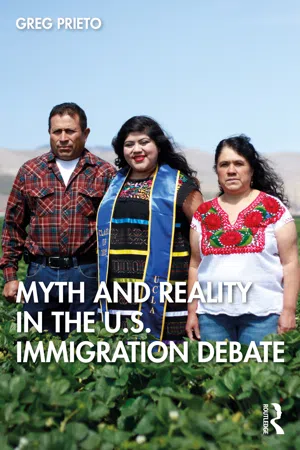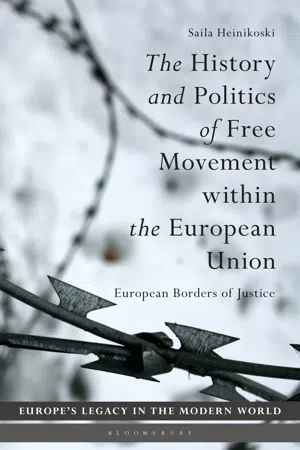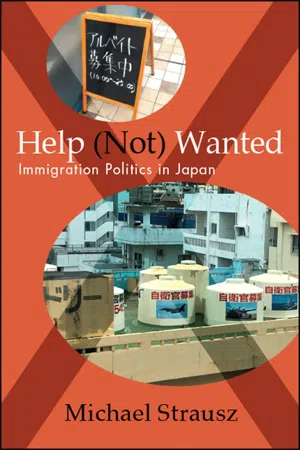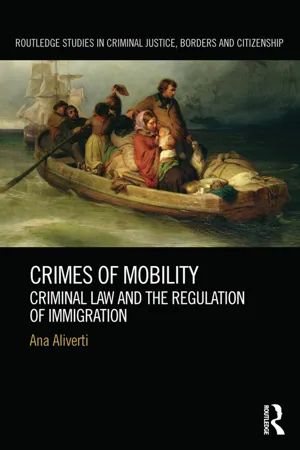Anti-Immigration Policies
Anti-immigration policies refer to government regulations and actions aimed at restricting or controlling the influx of immigrants into a country. These policies can take various forms, such as border controls, visa restrictions, and deportation measures. Throughout history, anti-immigration policies have been implemented for reasons including economic protectionism, national security concerns, and cultural preservation.
7 Key excerpts on "Anti-Immigration Policies"
- eBook - ePub
- Jane Freedman(Author)
- 2017(Publication Date)
- Routledge(Publisher)
...Chapter 2 The Development of Immigration Policy in a European Context In the years since the official suspension of labour migration in 1974 France has introduced a whole series of new laws to regulate immigration and the acquisition of nationality. These policies are specific to France with its particular history of immigration and conceptions of nationhood and citizenship. However, there are also growing external pressures which influence policies, particularly those emanating from continuing European integration. Immigration policies thus need to be considered within the context of France's membership of the European Union, and the continued attempts of the EU to agree on common immigration and asylum policies that they can enforce. The difficulties involved both in agreeing common immigration and asylum policies for all the member states of the EU, and then in implementing such policies if they were agreed, have been well-documented (Geddes, 2000). There is a growing tendency amongst European countries, however, to commit to ever-more restrictive targets on immigration, leading to the creation of what some have termed 'Fortress Europe'. One of the contributory elements to the maintenance of restrictive immigration targets has been their perceived electoral appeal, with governments thus wanting to appear 'tough' on immigration issues. As Geddes remarks: 'It is a sad fact that there are few votes in being nice to immigrants.' (Geddes, 2000: 26). Further, immigration has been seen more and more in terms of security, and this rationale has encouraged tighter and tighter controls being put in place. Immigration and asylum are seen as threats to the 'societal security' of states (Waever et al., 1993), posing a threat to national identities and hampering governments in their quest to control their populations. Increasingly also, immigration and asylum have been linked with the security threat posed by terrorism (Koser, 2001)...
- eBook - ePub
Myth and Reality in the U.S. Immigration Debate
The Myths and Realities of Immigration in the United States
- Greg Prieto(Author)
- 2020(Publication Date)
- Routledge(Publisher)
...immigration policy has undergone cycles of both restriction and liberalization. This historical cyclicality suggests that the immigration issue is neither new nor unprecedented. Important transformations in the structure of immigration policy have occurred, and yet the nativist anxieties of the past—that immigrants dilute white American culture, they bring crime and disease, they cost more than they contribute—continue to set the terms of the debate in the present. Even in those historical moments during which U.S. immigration policy has undergone liberal reform, the reasons for reform had as much to do with shifting geopolitical interests, domestic policy priorities, and changing political alliances as they did with a distinctly American humanitarianism. This resonance between the past and present treatment of immigrants means that the past has much to teach us. What might be learned from this history? Unfounded racial, economic, political, and religious anxieties have fueled restrictionist policy with disastrous consequences for immigrants since the founding of this country. 6 While the method and rationale for immigrant restriction has evolved, the fundamental suspicion of foreign “others” is as old as America itself. We will see that various U.S. industries, such as agriculture, construction, hospitality, and food service and processing, have long been dependent on immigrant labor, even as restrictionist efforts have prevented their broader social and political integration. Immigration scholars sum up this contradiction thusly, “we want your labor, but we don’t want you.” Immigrant labor is necessary, but immigrants themselves are unwanted. We also learn that both liberalizing and restrictionist policy often have major unintended consequences. Paying attention to the unanticipated impacts of policy reform in the past can inform our efforts at reform today...
- eBook - ePub
The History and Politics of Free Movement within the European Union
European Borders of Justice
- Saila Heinikoski(Author)
- 2020(Publication Date)
- Bloomsbury Academic(Publisher)
...It still seems that the past experiences of Italian emigration do not play out in the contemporary Italian politics (cf. Gabaccia 2003). Furthermore, it appears that in the Italian case, immigration and EU policies are tightly attached. People who are critical of immigration blame the EU for not helping Italy out with migration, encouraging people to become more EU sceptical at the same time. While the populist governments a decade ago were worried about EU citizens (particularly from Romania) constituting a security threat, currently the focus has shifted towards third-country nationals. 8.4 Migration policy in the UK: Restrictions to mobility towards the country Britain has been a popular target for immigration from all over the world, and the country has paid much effort in drafting restrictive immigration laws and policies (Geddes 2003 : 29–50). This is also one of the four particular characteristics identified by Anthony M. Messina in the British post-war migration history when compared to other countries. Furthermore, as a result of this curbing of labour migration, the British society has also been less penetrated by foreign workers than other large EU states. In addition, Britain has not experienced a major political anti-immigration movement (also due to the election system), and finally, it has been under fewer pressure of irregular migration, also thanks to being an island (Messina 2001 : 259–60). Although Messina made his observations in the turn of the millennium, the situation has not changed much. A good illustration of the differences to other European countries in curbing immigration is that Britain was exactly 100 years ahead of Germany in drafting its first immigration law, the Aliens Act of 1905 (Schain 2008 : 121). The Aliens Restriction Acts of 1914 and 1919 followed it; a comprehensive Immigration Act substituted the latter only in 1971. As the titles suggest, these acts have usually aimed at restricting immigration...
- eBook - ePub
Help (Not) Wanted
Immigration Politics in Japan
- Michael Strausz(Author)
- 2019(Publication Date)
- SUNY Press(Publisher)
...Catholic parties supported family reunification (Bonjour 2011: 103), and the cultural revolution of the 1960s led to allowing women to bring their families and people to bring gay partners (98–99). Moreover, the neoliberal norm of “personal responsibility” has justified restrictions in subsequent periods (110). Bonjour concludes by noting that “insight into the dynamics of policy making is only possible if we acknowledge, unlike Freeman and Messina, that policymaking in this field is indeed, to a significant extent, a morality play” (115). Popular accounts of immigration, along with conventional wisdom, often suggest that Japanese xenophobia has an important role in limiting immigration to Japan. One researcher at an interest group that represents Japan’s high-technology sector explained the reluctance of Japan’s politicians to even use the word “immigration” as follows: “For a long time an island country mentality has taken root among the Japanese, which suggests that we should not admit foreign residents and that we can only get along with ourselves” (interview 1140). He went on to argue that, although he personally supports immigration, there are some, even in his lobbying group, who prefer not to talk about immigration, although they do still discuss “foreign labor.” The problem with the argument that Japanese xenophobia limits immigration is clear when the argument is considered in comparative perspective. Xenophobia is relatively common throughout the world, and in many countries with large immigrant populations, there is a history of xenophobia. It is not hard to find the influence of xenophobic rhetoric when looking at historical policies and current platforms of major political parties in England, France, the United States, Germany, and elsewhere...
- eBook - ePub
Global Migration
Patterns, processes, and politics
- Elizabeth Mavroudi, Caroline Nagel(Authors)
- 2016(Publication Date)
- Routledge(Publisher)
...After a great deal of wrangling and compromise, the amnesty was incorporated into the legislation, providing a path of legalization for approximately three million undocumented immigrants (for a fuller discussion, see Joppke, 1998). Meanwhile, continued lobbying by agribusiness interests ensured that only a miniscule percentage of the federal budget would be dedicated to the enforcement of laws against hiring undocumented workers (Andreas, 2000). Freeman (1995) argues that while these special-interest politics and expansionary tendencies are especially evident in traditional settler societies like the US, they are also present in European societies. European politics, he argues, have become increasingly like those in the US, with organized interest groups and elite consensus, rather than public opinion, driving immigration policies and the implementation of immigration laws. So, for instance, Boswell (2007) demonstrates that heightened public concern about security after the September 11, 2001, terrorist attacks had little substantive impact on immigration policy because immigration bureaucracies were relatively insulated from securitarian impulses by their own bureaucratic practices. Civil servants, in many European contexts, were able to operate largely as they had before and to follow their own (relatively liberal, pro-business) policy aims (also Lahav, et al., 2014). Joppke (1998) offers a related analysis of expansionary immigration policies in Europe. Observing that ‘only liberal states are plagued by the problem of unwanted immigration’, Joppke argues that positive net migration in Europe is driven primarily by the liberal-democratic principles and humanitarian norms that were inscribed in European constitutions after World War II...
- eBook - ePub
Migrants and Natives - ′Them′ and ′Us′
Mainstream and Radical Right Political Rhetoric in Europe
- Kristina Boréus(Author)
- 2020(Publication Date)
- SAGE Publications Ltd(Publisher)
...1 Anti-immigration and anti-migrant rhetoric as part of politics Aims of the book This book analyses political rhetoric, contextualising it in a changing political landscape. The object of study is rhetoric on immigration and migrants produced by parliamentarian political parties in the context of general election campaigns between 1986 and 2019. Not all rhetoric is made from a threat perspective on immigration or from a native dominance perspective; in the next two chapters alternative perspectives will be introduced. The book, however, focuses on rhetoric that is strongly negative to immigration, and rhetoric that attacks and denigrates migrants or proposes politics that would make their lives more difficult. I refer to such rhetoric as anti-immigration and anti-migrant rhetoric, respectively. Describing and comparing national rhetoric The first aim of the book is to give a systematic comparative account of rhetoric on migration and integration policy, especially regarding its anti-immigration and anti-migrant content, as expressed in election campaigns in Austria, Denmark and Sweden, thereby showing national characteristics of this kind of rhetoric, as well as what it has in common. The choice of the three countries is motivated by an interest in the influence on politics, especially its rhetorical part, of the radical right parties – henceforward often RR parties – that have grown rapidly during the last decades. The three countries are small prosperous European welfare states, all EU members...
- eBook - ePub
Crimes of Mobility
Criminal Law and the Regulation of Immigration
- Ana Aliverti(Author)
- 2013(Publication Date)
- Routledge(Publisher)
...2 Tracing the history of immigration controls in Britain (from the late 1700s to the mid-1990s) Britain has a long and established history of immigration. It has been a point of arrival for people from many latitudes, cultures and places. French insurgents, Jews, Irish, Polish, old and new Commonwealth citizens have all arrived at different times and in large numbers. Britain has one of the largest migrant resident and naturalized populations in Europe, and is still an important destination for asylum seekers (Gibney and Hansen 2003). This chapter traces the first pieces in the construction of the British immigration system and its development in the twentieth century in order to understand the origins of and rationale for recent policies. I will, therefore, provide a brief historical background of immigration legislation and debates before discussing more recent policies in this field. British immigration legislation, since the early twentieth century, established harsh controls over non-nationals and continuously expanded the category of ‘exclusionable’ foreigners. In contrast to the more widely accepted view in criminology (e.g. Albrecht 2000; Miller 2003; Wacquant 2006; De Giorgi 2010; Sklansky 2012), I will demonstrate that the criminalization of migration is not new. Immigration-related offences or ‘immigration crimes’ – some of them punishable by imprisonment – have been incorporated in immigration statutes since the late 1700s. The development of British immigration controls [A]nd the East End of London was being swamped by aliens who were coming in like an army of locusts, eating up the native population or turning them out. 1 In the late eighteenth century, there was an influx of French émigrés to Britain, following the radicalization of the French Revolution which led to the formation in France of the Committee of Public Safety during the ‘Reign of Terror’...
